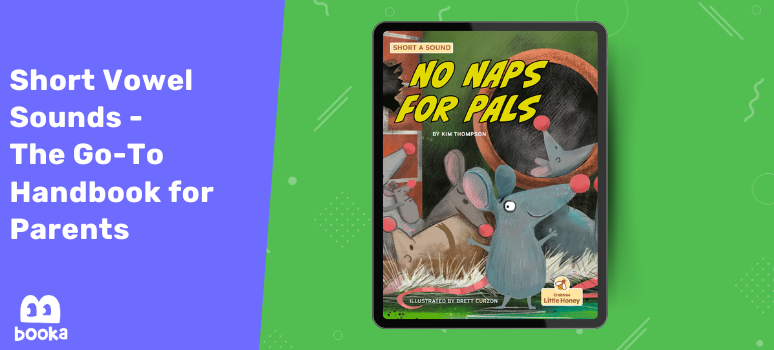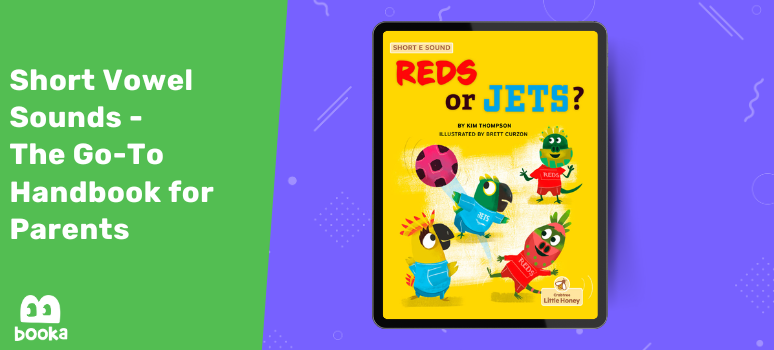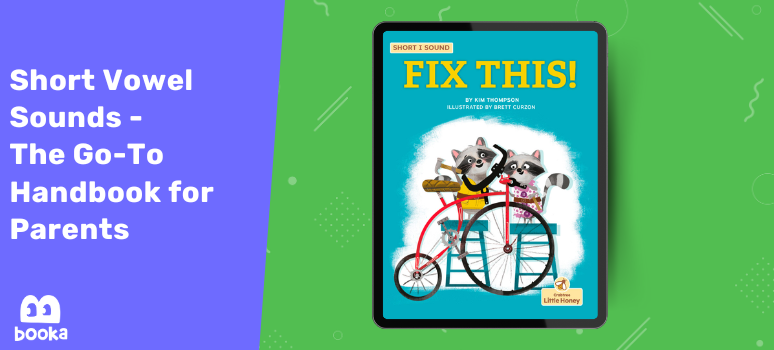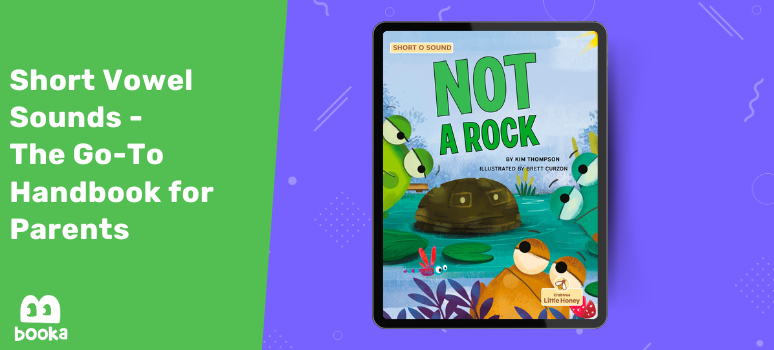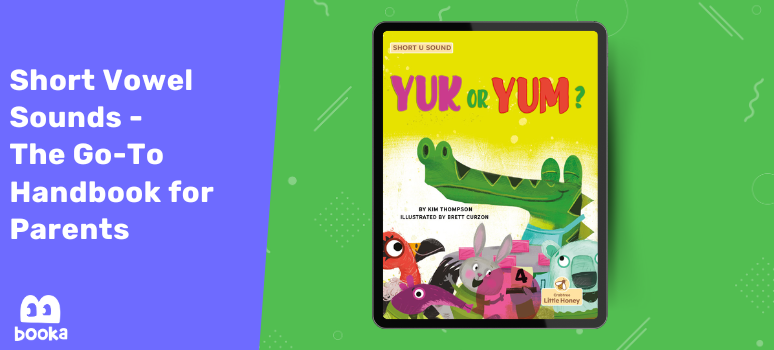Short vowel sounds play a key role in early reading development and are often the first sounds children learn when beginning phonics. Learning to recognize and pronounce short vowel sounds helps kids decode new words, build fluency, and gain confidence as readers.
In this guide, we’ll explain what short vowel sounds are, how they differ from long vowels, and how to teach them at home. You’ll also find helpful short vowel word lists, examples, rules, and short vowel books to support your child’s learning.
Whether you’re a parent, caregiver, aunt, uncle, grandparent, etc., this article has everything you need to get started with short vowel practice! So, let’s get into it!
Quick Overview - Short Vowel Basics in 60 Seconds
Don’t have time to read the full article? No problem! Here’s what you need to know.
- Short vowel sounds are the quick, simple sounds found in early reading words like “cat,” “bed,” “pig,” “hot,” and “sun.”
- Each vowel—A, E, I, O, and U—has a short sound.
- Short vowel sounds are most common in CVC words (consonant–vowel–consonant), which are often the first words children learn to read.
The five short vowel sounds are:
- Short A = /ă/ as in apple, cat, map
- Short E = /ĕ/ as in elephant, bed, pen
- Short I = /ĭ/ as in igloo, pig, sit
- Short O = /ŏ/ as in octopus, hot, log
- Short U = /ŭ/ as in umbrella, sun, cup
You can tell if a vowel is short if:
- It’s in a CVC word (like “cat,” “pen,” “hop”)
- It’s part of a closed syllable (syllable ends in a consonant)
- The letter doesn’t say its name (e.g., “apple” has a short a, but “ape” doesn’t)
- It often comes before double consonants (e.g., “kitten,” “butter”)
Watch for exceptions! For example, some CVC words don’t follow these rules (e.g., “was,” “friend”), pronunciation can vary by region (e.g., “bath” in the UK vs. the US), and some words have irregular spellings.
- Tips for teaching short vowel sounds at home:
- Start with one vowel at a time (short A is a good first choice)
- Practice at home with the help of sound sorting, vowel games, and other short vowel activities
- Read phonics-based books that focus on one short vowel sound. Recommended books include No Naps for Pals (short A sound) and Yuk or Yum? (short U sound). See a complete list of short vowel books below.
- Keep lessons short, fun, and hands-on—5 to 10 minutes is enough!
What are short vowel sounds?
Short vowel sounds are the simple vowel sounds we hear in everyday words like “cat,” “bed,” “pig,” “hot,” and “sun.” Unlike long vowels, which say their own name (like the ‘a’ in “cake” or the ‘o’ in “rope”), short vowels make quick, short sounds that match the spoken pronunciation of the letter.
There are five short vowel sounds in English—one for each vowel—A, E, I, O, and U.
Examples of Short Vowel Sounds
- Short A = /ă/ as in apple, cat, map
- Short E = /ĕ/ as in elephant, pen, bed
- Short I = /ĭ/ as in igloo, pig, sit
- Short O = /ŏ/ as in octopus, hot, log
- Short U = /ŭ/ as in umbrella, sun, cup
These vowel sounds are most commonly found in CVC (consonant–vowel–consonant) words, such as cat, pen, and rug. These are often the first words children learn to read, making short vowels a key part of early literacy.
Why are short vowel sounds important?
Short vowels are the foundation of early phonics and are usually the first vowel sounds children learn when beginning to read in English. That’s because short vowels are:
- Simple to pronounce
- Common in high frequency words
When kids master short vowel sounds, they can decode words more easily. This leads to:
- Better reading fluency
- Stronger spelling skills
- A deeper understanding of how English words are built
So, if you’re teaching your child to read at home, starting with short vowels is one of the most effective and helpful first steps!
Short Vowels vs Long Vowels
Understanding the difference between short vs long vowel sounds is an essential part of learning to read in English. These two vowel types show up in many beginner-level words and often follow predictable spelling patterns.
So, what’s the difference between short and long vowels? Here’s what you need to know.
The Difference Between Short vs Long Vowels
- Short vowels are quick, simple sounds that are pronounced by saying the sound the letter makes. For example, the ‘a’ in “cat” makes the short a sound (i.e., /ă/)—not “ay.”
- Long vowels sound exactly like the name of the letter. For example, the ‘a’ in “cake” says “ay”—the long a sound.
Examples of Short vs Long Vowels
Here are some clear examples to make it easier to understand the difference between long and short vowel sounds.
A
Short Vowel Sound, Example: /ă/, cat
Long Vowel Sound, Example: /ā/, cake
E
Short Vowel Sound, Example: /ĕ/, pen
Long Vowel Sound, Example: /ē/, pea
I
Short Vowel Sound, Example: /ĭ/, pig
Long Vowel Sound, Example: /ī/, bike
O
Short Vowel Sound, Example: /ŏ/, hot
Long Vowel Sound, Example: /ō/, home
U
Short Vowel Sound, Example: /ŭ/, sun
Long Vowel Sound, Example: /ū/, cube
How to Tell If a Vowel Is Long vs Short
- Long vowels usually appear in:
- Vowel consonant e words (or magic e words) such as “like,” “home,” and “cape.”
- Vowel teams like “rain,” “boat,” and “read.”
- Short vowels are most often found in CVC words (consonant-vowel-consonant) like “mad,” “net,” and “hop.”
Knowing these rules and patterns makes it easier for kids to guess the correct vowel sound when reading new words.
Why It Matters
Knowing how to tell if a vowel is short or long helps children:
- Sound out unfamiliar words correctly
- Recognize common spelling patterns
- Improve reading fluency and spelling accuracy
In short, this foundational skill supports stronger reading, writing, and confidence—especially in the early stages of learning to read.
Short Vowel Rules - How to Tell If a Vowel Is Short
If you’re wondering how to tell if a vowel is short, you’re not alone. Many parents and caregivers ask this question when teaching kids to read.
The good news? Short vowel sounds usually follow clear, consistent patterns—especially in early reading words. These patterns are easy to spot once you know what to look for.
Below are five simple short vowel rules to help you and your child recognize them when practicing reading at home.
Rule #1: CVC Words Usually Have Short Vowel Sounds
If a word follows the consonant–vowel–consonant (CVC) pattern, the vowel is almost always short. Examples: “cat,” “bed,” “pig”, ‘hop,” “sun.”
RULE TO REMEMBER: Vowels in CVC words are usually short vowels.
Rule #2: A Single Vowel Between Two Consonants Is Often Short
When a single vowel appears between two consonants in a word or syllable, it typically makes a short vowel sound. Examples: “pen,” ‘net,” ‘dog,” ‘run.”
RULE TO REMEMBER: If there’s only one vowel between consonants, it’s usually short.
Rule #3: Short Vowels Appear in Closed Syllables
A vowel in a closed syllable typically makes a short vowel sound. *A closed syllable ends in a consonant and contains just one vowel. Examples of closed syllables with short vowel sounds include nap-kin, pic-nic, and lem-on.
RULE TO REMEMBER: Syllables that end in a consonant often signal short vowels.
Rule #4: Short Vowels Do NOT Say Their Letter Name
Unlike long vowels, short vowels sound different from the letter’s name in the alphabet. For example, short a (/ă/) sounds like ‘a’ as in “apple,” not ‘ay’ as in “ape.”
RULE TO REMEMBER: If a vowel doesn’t sound like its name, it’s likely a short vowel.
Rule #5 - Double Consonants Often Signal a Short Vowel
When a vowel is followed by two of the same consonant (like ‘tt,’ ‘pp,’ or ‘ll’), the vowel is usually short. Examples: “butter,” “kitten,” ‘happy,” “muffin.”
RULE TO REMEMBER: Double letters right after a vowel are often a clue to a short vowel sound.
Are there exceptions to short vowel rules?
Yes—while short vowel rules are reliable most of the time, like most things in English, there are exceptions to short vowel rules.
Here are a few exceptions to watch for when teaching your child to recognize and read short vowel sounds.
Exception #1: Some CVC Words Don’t Have a Short Vowel
Although CVC patterns usually mean the vowel is short, some words don’t follow this rule.
- Example: “was”
- In “was,” the ‘a’ sounds more like /ŭ/ (wŭz) — not /ă/ as expected.
Tip: When a word doesn’t follow the rule, explain that it’s a “rule breaker” or a “tricky word.”
Exception 2: Pronunciation Can Vary by Region
In some countries (like the US, UK, Australia, or India), short vowels may be pronounced slightly differently.
- Example: The short ‘a’ in “bath” is pronounced /æ/ in the US (bath), but often /ɑː/ in British English (bahth).
- Example: In some UK dialects, “was” may sound closer to /woz/.
Exception 3: Some Words Have Irregular Spellings
Words like “friend” may look like they should have a long vowel, but they sound like short vowels.
- Example: “Friend” is spelled with the vowel team ‘ie’ but sounds like it has a short e: /frĕnd/.
Tip: Teach kids that some words have unexpected spellings and need to be learned through exposure and repetition.
The 5 Short Vowel Sounds with Examples (A, E, I, O, U)
Each vowel in the English alphabet — A, E, I, O, and U — has a short vowel sound. Below is a breakdown of each short vowel sound, including the phonetic pronunciation and common examples:
Short A Sound – /ă/
- Sounds Like: the ‘a’ in “apple” (a fast, unstressed sound made with an open mouth, the tongue low and back, and a relaxed jaw)
- Examples of short A words: cat, map, bag, hat, mad, fan, jam, nap
Tip: Short A is often found in words where ‘a’ is between two consonants, like in “cat” or “pan.”
Short E Sound – /ĕ/
- Sounds Like: the ‘e’ in “elephant” (a short, gentle sound made by raising the middle of your tongue lifted slightly toward the roof of your mouth, with your mouth partly open)
- Examples of short E words: bed, pen, net, red, jet, ten, leg, step
Tip: The short E sound can be tricky for some kids to hear. Use rhyming words like “red” and “bed” for practice.
Short I Sound – /ĭ/
- Sounds Like: the ‘i’ in “igloo” (a short, high sound made with a relaxed, slightly open mouth and the tongue positioned high and toward the front)
- Examples of short I words: pig, sit, zip, big, win, pin, dig, tip
Tip: Short I is often confused with short E. Try stretching the short vowel sounds slightly—e.g., iiiit—to help kids hear them more clearly.
Short O Sound – /ŏ/
- Sounds Like: the ‘o’ in “octopus” (a rounded “ah” sound from the back of the mouth, with the mouth a little more open than when making the short ‘a’ sound)
- Examples of short O words: hot, log, pot, top, fox, hop, mop, cob
Short U Sound – /ŭ/
- Sounds Like: the ‘u’ in “umbrella” (a gentle, neutral sound from deep in the mouth, with the tongue low and the jaw relaxed)
- Examples of short U words: sun, cup, bug, run, mud, rug, pup, fun
Tip: The short U is often the trickiest because it's so subtle. Say the word “up” slowly and clearly to model the sound.
Short Vowel Word Lists by Sound (A, E, I, O, U)
Once your child is familiar with each short vowel sound, it’s helpful to practice with real words.
The short vowel word lists below are organized by vowel and include easy CVC (consonant-vowel-consonant) words that use one short vowel sound.
These short vowel word lists are great for practice at home, during read-alouds, or while playing phonics games.
Short A Word List (/ă/)
- cat
- map
- bag
- nap
- fan
- jam
- hat
- bat
- man
- tap
- lap
- van
- cap
- mat
- pad
Short E Word List (/ĕ/)
- bed
- red
- pen
- net
- leg
- ten
- hen
- pet
- vet
- jet
- met
- peg
- step
- men
- get
Short I Word List (/ĭ/)
- pig
- dig
- sit
- tip
- win
- zip
- lip
- rip
- bit
- hit
- kit
- fin
- pin
- mix
- fix
Short O Word List (/ŏ/)
- hot
- pot
- mop
- top
- pop
- fox
- log
- dog
- hop
- cop
- cob
- rod
- job
- box
- dot
Short U Word List (/ŭ/)
- sun
- cup
- bug
- rug
- run
- bun
- fun
- nut
- cut
- mud
- tub
- gum
- hug
- pup
- jug
Now, with these short vowel word lists in hand, you’re ready to start teaching short vowels at home! Here’s how.
How to Teach Short Vowel Sounds at Home
Teaching short vowel sounds at home can be fun, simple, and incredibly effective—especially when you use hands-on activities and real-life examples.
Whether your child is just beginning to read or needs extra support, you can use the tips below to teach short vowels at home.
Here’s how to get started.
1. Focus on One Short Vowel Sound at a Time
Start with just one short vowel (recommendation: short A) before introducing others. Once your child can hear and say the sound, move on to short E, I, O, and U.
- Say the sound slowly and clearly (e.g., /ă/ as in apple)
- Point to pictures or objects that start with that sound
- Repeat the sound together several times a day
PRO TIP: Use familiar words and daily routines (e.g., “a-a-apple at breakfast”) to reinforce sounds.
2. Practice Short Vowel Sounds Using CVC Words
CVC (consonant-vowel-consonant) words are perfect for short vowel practice. These simple words use a short vowel sound in the middle and are easy to blend.
- Write or sound out words like “cat,” “pen,” “pig,” “hot,” and “sun.”
*Check out our CVC Words List for more practice words.*
- Encourage your child to tap or clap each sound: /c/ – /a/ – /t/
- Use letter cards or magnetic letters to build and swap words
3. Try Sound Sorting Activities
Sound sorting is a great way to help children distinguish between short vowel sounds. In this simple game, your child will sort words or pictures into groups based on the vowel sound they hear.
Here’s how to do it:
- Set up five sorting areas — one for each short vowel sound. For example, label folders, trays, bowls, or sections of a table with A, E, I, O, and U.
- Print or draw picture cards of simple CVC words.
Example images: cat, bed, pig, dog, sun
You can also use word cards if your child is already reading.
- Say each word aloud together and ask your child: “What vowel sound do you hear in this word?”
- Have your child place the card in the tray or folder that matches the short vowel sound.
- Repeat and review. Mix up the cards and sort again to reinforce the differences between sounds—especially tricky ones like short E and short I.
Why this works: Sound sorting builds phonemic awareness, helping kids learn to hear, compare, and isolate vowel sounds in words—an essential skill for reading success.
4. Play Short Vowel Games
Games make learning stick! Try these fun short vowel games.
- Vowel Hop: Write short vowel words on sticky notes and place them on the floor. Call out a sound or word and have your child hop to the correct one.
*Don’t Forget: Make sure the sticky notes are securely attached to the floor or have your child jump and land in a space beside the sticky note—to make sure no one falls!*
- Vowel Matching: Match pictures to their corresponding vowel sound.
- Draw & Say: Draw a picture (e.g., a cup) and have your child say the word and identify the vowel.
4. Read Short Vowel Books Together
One of the best ways to teach short vowel sounds at home is with the help of books for kids!
Here’s how to effectively use short vowel books.
- Read aloud slowly and point to each word
- Emphasize the vowel sound in key words
- Reread the book to build confidence and reading fluency
PRO TIPS: Here are some helpful tips for using short vowel sound books to teach short vowels at home.
- Choose just right books.
- Use a kid's reading app like Booka to access hundreds of phonics-friendly stories all in one place.
Explore our short vowel book recommendations below.
6. Be Patient and Keep It Fun
Short vowels can be tricky—especially short E and short I, which sound similar. If your child mixes them up, don’t worry! That’s normal.
- Gently repeat the correct sound
- Praise effort over perfection
- Keep practice short and playful (5 to 10 minutes is plenty!)
Teaching short vowel sounds doesn’t require a formal lesson plan—just consistency, encouragement, and a few fun strategies. With practice, they’ll start to recognize patterns, build confidence, and become a more fluent reader.
Ready to teach short vowel sounds? Here are some recommended books to help you get started.
Books That Emphasize Short Vowel Sounds
One of the easiest ways to teach short vowel sounds at home is by reading books that focus on just one vowel at a time. These phonics-based or decodable books are designed to help children practice short vowels in context, using simple words they can sound out independently.
Below, you’ll find a list of recommended books that highlight short A, E, I, O, and U.
No Naps for Pals
By Kim Thompson
Illustrated by Brett Curzon
No Naps For Pals is a decodable book that focuses on the short ‘a’ sound, making it ideal for early readers who are just starting to explore CVC words. Throughout the story, your child will encounter a variety of simple, short A words, such as “cap,” “gas,” “lap,” “nap,” “rat,” “sat,” and “tag.”
To further support learning, the book includes a helpful word-and-picture grid at the beginning. This visual reference shows each short “a” word featured in the story alongside a matching image—making it easier to connect words with their meanings and build vocabulary, comprehension, and confidence.
Featured Short Vowel Sound: Short A
Suitable for Ages: 4 to 8 (preschool and up)
Reds or Jets?
By Kim Thompson
Illustrated by Brett Curzon
Reds or Jets? is a fully decodable children's picture book that features high-frequency words and short e vowel sounds. Some of the short e words featured in the book include “fed,” “red,” “fell,” “leg,” “jet,” “led,” “ref,” “set,” and “tell.”
Like No Naps for Pals, this kid's book also includes a helpful visual reference grid at the beginning that shows each short e word in the story alongside a matching image—to make it easier for kids to recognize these words and connect them with their meanings.
Featured Short Vowel Sound: Short E
Suitable for Ages: 4 to 8 (preschool and up)
*Available as a read aloud story with professional narration on the Booka reading app.*
Fix This!
By Kim Thompson
Illustrated by Brett Curzon
Fix This! is another excellent decodable reader written by Kim Thompson. The story includes numerous CVC, VC, and high-frequency words that have a short i vowel sound—like “bits,” “fit,” “in,” “sing,” “ring,” “six,” “sit,” “thing,” and “fix.”
Similar to Reds or Jets? and No Naps for Pals, this short vowel sound book includes a grid at the beginning that shows all the new words in the story, along with pictures that illustrate their meaning.
Featured Short Vowel Sound: Short I
Suitable for Ages: 4 to 8 (preschool and up)
Not a Rock
By Kim Thompson
Illustrated by Brett Curzon
Not a Rock is a decodable story for kids that focuses on the short o vowel sound. In fact, every letter ‘o’ that appears in the story makes the short o sound!
The story features the following short o words: “bob,” “dock,” “dot,” “hop,” “hot,” “pop,” “rock,” “sob,” and “top.” These words are also featured in a sounds and letters chart with images that depict the meaning of each word—to make it easier for young readers to identify and understand the meaning of these new words.
Featured Short Vowel Sound: Short O
Suitable for Ages: 4 to 8 (preschool and up)
*Available as a read along book (with professional narration) on the Booka reading app for kids.*
Yuk or Yum?
By Kim Thompson
Illustrated by Brett Curzon
Yuk or Yum? is a fun children’s story that will help you teach the short u vowel sound at home. The book uses the short u sound in VC, CVC, and high-frequency words throughout the story.
Examples of the short u words used include “bugs,” “gum,” “yuk,” “mug,” “rush,” “sub,” “mush,” “up,” and “yum.” These words are also featured in a chart alongside images that show their meaning.
Featured Short Vowel Sound: Short U
Suitable for Ages: 4 to 8 (preschool and up)
You can find these stories and many more kid’s books with short vowel sounds on Booka. Download the Booka app today and start reading for free!
PRO TIP: To find short vowel books in the Booka reading app for kids, simply open the app, navigate to the search page (look for the magnifying glass icon), and type “vowels” into the search bar!
Practice Short Vowels at Home with Booka
Ready to help your child master short vowel sounds? Explore phonics-based books and learning games in the Booka app!
With decodable stories designed to highlight short vowels, Booka makes it easy for your child to practice reading in a fun, engaging way—anytime, anywhere.
Download the Booka app today and start building confident, happy readers—one short vowel at a time.
